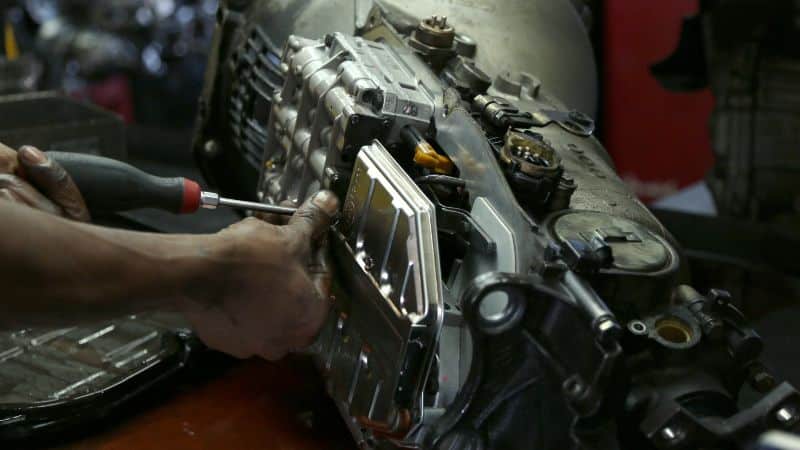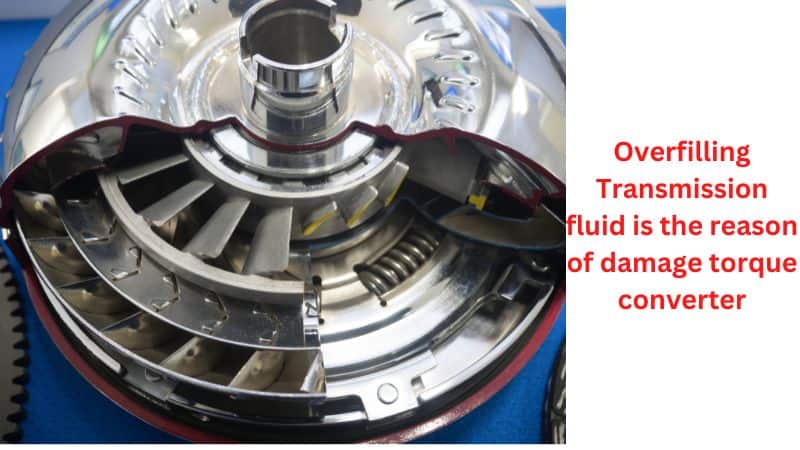When it comes to car maintenance, there are a lot of things that we can do to keep our vehicles in good shape. One of these is keeping our transmission fluid topped up. But did you know that there are consequences to overfilling your transmission fluid?
Overfilling your transmission fluid can cause all sorts of problems, from decreased fuel efficiency to complete system failure. In this article, we’ll discuss some of the effects of overfilling transmission fluid and the symptoms as well. So; keep reading this article.

The Symptoms of Overfilling Transmission Fluid
Overfilling your vehicle’s transmission fluid can cause several problems. But before that; it’s essential to know the symptoms of too much transmission fluid in the car. So; check out these symptoms.
Trouble Shifting Gears
If you’re experiencing difficulty switching gears, it may be the symptom of the overfilled CVT transmission. When the fluid level is too high, it can force the transmission to operate in an overheated condition, which will make it difficult or impossible to change gears.
This can cause the gears to slip, jerk, or refuse to shift while driving. The driver may experience a sudden lack of acceleration or a feeling of grinding when attempting to switch gears. If left unchecked, this issue can lead to further damage to the transmission and require costly repairs.
Engine Overheating
The most important purpose of a transmission fluid pump is to protect the system from overheating, so it may not be too obvious that it might be overheating.
But the problem is when there is too much transmission fluid in the system it doesn’t work as it should. It won’t be as effective at cooling things down, which causes the engine to overheat due to too much fluid!
Some common symptoms of engine overheating include a red warning light on the dashboard, a high-pitched whine coming from the engine, and a loss of power. If you experience any of these symptoms, it’s important to take your car to a mechanic right away.
High Fluid Level on Dipstick
One of the more obvious signs that you have overfilled your transmission fluid is that you’ll notice it on your dipstick. It has a “Full” marking on it, and if the fluid is above that, then you know you’ve gone too far.
The overfilled fluid can cause some issues in the transmission, as it can interfere with the control of the transmission and can cause some excess wear and tear on your gears. Because of the high pressure inside, it can also lead to leaking fluid from around gaskets or seals.
To be sure that this is indeed an issue related to too much transmission fluid, check your owner’s manual for further details about how much should be used about your car’s make and model. If you do find it’s too high, draining some transmission fluid is in order. Hopefully, this simple task will help get your car running smoothly again!
Odd Noises
As it’s a viscous liquid, the sound of transmission fluid being circulated will sound like a low humming noise. But if there’s too much of it in the system, you may hear louder humming noises that you don’t usually hear.
If you’ve never heard transmission fluid circulating, it’s a good idea to take a quick listen to what it sounds like when the car is running in neutral gear. This way you can compare that sound with what you’re hearing when the car is running with too much fluid in it.
If the difference is drastic, that’s likely an indication that too much fluid has been put into the system. Be sure to shut off the engine and check the levels immediately as this can cause damage if left unchecked for too long.

What are the Effects of Overfilling Transmission Fluid?
Overfilling your transmission fluid can cause a variety of issues in your vehicle’s transmission system. Check out the effects that can happen from transmission fluid slightly overfilled.
Increased Heat
One of the effects of overfilling transmission fluid is increased heat. This is because when the transmission fluid is overfilled, the fluid level rises in the transmission and creates a pocket of air. This pocket of air acts as a barrier and prevents the transmission from dissipating heat properly, resulting in increased temperatures.
The increased heat can cause the transmission to wear out faster, resulting in a need for more frequent repairs or even a total transmission failure. It can also cause the transmission to shift poorly and make it difficult to control the vehicle.
Slipping Gears
The effects of overfilling transmission fluid can be far-reaching, leading to a variety of issues with your car’s transmission. You may be thinking; Will too much transmission fluid make it slip? The answer is ‘YES’.
Slipping gears is one of the most common symptoms of an overfilled transmission, and it can have a major negative impact on your car’s performance.
It happens when the transmission fluid level is too high, causing the gears to become too slippery and not engage properly. This can cause the transmission to slip out of gear, creating a jerking sensation and a noticeable loss of power.
In some cases, this can also lead to increased wear and tear on the transmission as the gears are constantly slipping and not engaging correctly.
Reduced Efficiency
Overfilling your transmission fluid not only can cause leaks but can also lead to reduced efficiency. Your car’s transmission is a critical part of its operation, and transmission fluid helps keep it cool and operating smoothly.
When you overfill your transmission fluid, it can cause the fluid to foam and may reduce its ability to lubricate and cool your transmission. This can lead to your transmission overheating and failing prematurely.
Clutch Damage
Overfilling transmission fluid can also lead to clutch damage. The condition of an overfilled transmission fluid is that it is quite vulnerable to foaming. As a result, any excess fluid that builds up can decrease the pressure in the system, leading to a drastic drop in efficiency and performance.
It means that when you change gears, your clutch may not work as intended; it won’t engage or disengage properly. And this can eventually lead to premature wear and tear on both the clutch assembly as well as the flywheel. So make sure you don’t overfill your transmission fluid if you want your car to last longer!
Damage to the Torque Converter
Another common effect of overfilling transmission fluid is damage to the torque converter. When the transmission fluid gets too hot, it causes the torque converter to break down. This can cause excess wear and tear on the internal components of the torque converter, leading to reduced power output and slower responses. In some cases, overfilling can cause complete failure of the torque converter, leading to costly repairs or even replacement.
As the torque converter works by transferring heat generated from the engine to create power for your vehicle, overfilling can lead to higher temperatures in your car’s engine as well. This can cause significant problems with your engine and other parts such as spark plugs and fuel injectors.
To avoid damage from overfilling your transmission fluid, it’s important to follow your vehicle’s manufacturer’s instructions for checking and refilling transmission fluid regularly. Doing this will help keep your vehicle running at peak efficiency and avoid any costly repairs due to fluid accumulation or overheating in the transmission system.

Strategies to Avoid Overfilling the Transmission Fluid
You already have some ideas about what happens if you overfill a CVT transmission. Now it’s important to take measures to avoid it. Here are some strategies to keep in mind:
1. Stick to the recommended fill level. Transmission fluid levels vary from car to car, so always refer to the owner’s manual or a reputable source like an auto technician to find out the correct fill level for your vehicle.
2. Use a funnel when adding fluid. This will help you avoid spilling and overfilling.
3. Check the fluid level regularly and before long trips. which will help you to catch any potential problems before they become dangerous.
4. Keep regular monitoring of the temperature of Gage. If you see the needle start creeping up, pull over and check the fluid level immediately. You may need to add more fluid if it’s low.
5. Use the right type of transmission fluid for your car. There are different types of transmission fluids designed for different makes and models of cars, so be sure to use the right one.
6. Bring your car in for regular maintenance checks. An auto technician can not only check the transmission fluid level but also clean and replace old fluid, ensuring that your car is running smoothly.
How to Remove Too Much Transmission Fluid
If you have added too much transmission fluid to your vehicle, it can cause serious damage to your transmission if left unchecked. But you’re lucky to know that it is possible to safely remove excess transmission fluid and return the vehicle to normal. Here is a step-by-step guide on how to remove too much transmission fluid.
1. Start by finding the transmission dipstick. This will be located in different places depending on your make and model of vehicle, but generally, it is close to the engine near the front of the car.
2. Remove the dipstick and wipe it clean with a rag.
3. Reinsert the dipstick and check the level of transmission fluid. If it is overfilled, you will need to remove some of the excesses.
4. Locate the transmission drain plug, which will be at the bottom of the transmission. It should be relatively easy to identify.
5. Use a wrench to loosen the drain plug, and then allow the excess transmission fluid to drain out.
6. After all the excess fluid has been removed, re-tighten the drain plug.
7. Dip the dipstick back in and check the fluid level. Make sure it is at the correct level and not overfilled.
8. Once the correct level of transmission fluid has been achieved, replace the dipstick and your vehicle should be back to normal.
By following these steps, you can safely remove too much transmission fluid from your vehicle and avoid any potential damage. It is important to always check the transmission fluid level regularly to make sure that it is at the correct level and not overfilled.
Final Thought
When it comes to your car’s transmission, it’s important to keep the fluid levels in check. Overfilling transmission fluid can have several negative consequences. The effects of overfilling transmission fluid can cause lots of damage to your vehicle.
If you’re not sure how to check and/or refill your car’s transmission fluid, be sure to consult your owner’s manual or take it to a trusted mechanic. Keep your car’s transmission in good shape by avoiding overfilling the transmission fluid and ensuring that the fluid levels are always within the recommended range.
Read Also:
